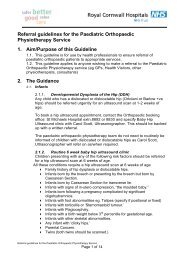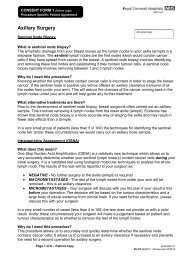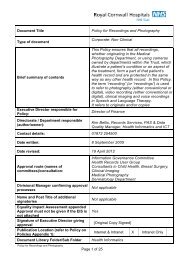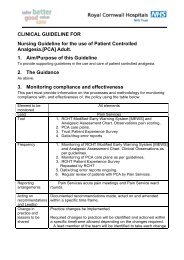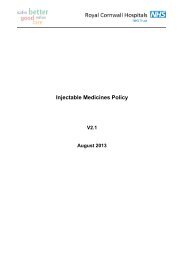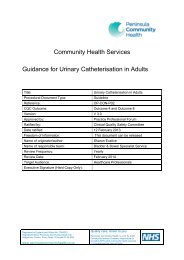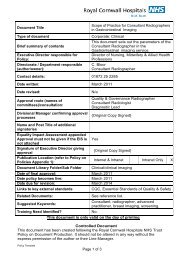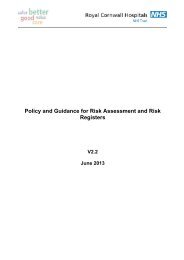(CVC) Management Guidance - the Royal Cornwall Hospitals Trust ...
(CVC) Management Guidance - the Royal Cornwall Hospitals Trust ...
(CVC) Management Guidance - the Royal Cornwall Hospitals Trust ...
Create successful ePaper yourself
Turn your PDF publications into a flip-book with our unique Google optimized e-Paper software.
Repeated specimen collection<br />
6 Staff Who Can Manage / Access <strong>CVC</strong>’s<br />
Staff managing <strong>CVC</strong>’s in <strong>the</strong> PCH must fulfil <strong>the</strong> following criteria:<br />
Are a registered healthcare professional<br />
Have successfully completed PCH Intravenous Drug (I.V.) <strong>the</strong>rapy course and<br />
fulfilled <strong>the</strong> PCH competency assessment<br />
Must have completed fur<strong>the</strong>r training in <strong>the</strong> management of central lines<br />
Have been assessed as competent in <strong>the</strong> management of <strong>the</strong>se devices<br />
7 Insertion of <strong>CVC</strong>’s<br />
A <strong>CVC</strong> line will only be inserted in an acute setting unless specific arrangements have been<br />
made with <strong>the</strong> acute care team for insertion in a community hospital. In <strong>the</strong> case of <strong>the</strong> latter<br />
X-ray facilities must be available on site. A detailed care plan must support <strong>the</strong> insertion for<br />
care and maintenance of <strong>the</strong> device.<br />
8 Care of Central Venous Ca<strong>the</strong>ters<br />
8.1 Dressings (i.e PICC & Hickman style) (refer to appendix 1)<br />
The central venous ca<strong>the</strong>ter (<strong>CVC</strong>) / central venous access device (CVAD) must<br />
be carefully observed to assess if <strong>the</strong> dressing is intact and to detect any early<br />
signs of infection e.g. redness and warmth.<br />
No antimicrobial ointments should be used on <strong>the</strong> ca<strong>the</strong>ter site<br />
ANTT with sterile gloves must be used for all <strong>CVC</strong> dressings and procedures (see<br />
Appendix ).<br />
A Chloraprep® applicator of 3mL Chlorhexidine 2% in Alcohol 70% must be used<br />
to clean <strong>the</strong> skin area before new dressing is applied.<br />
The dressing of choice is <strong>the</strong> Central Line I.V. 3000®. This dressing has a high<br />
Moisture Vapour Transmission Rate (MVTR) which helps remove moisture build<br />
up and <strong>the</strong>refore reducing <strong>the</strong> ideal environment for bacteria.<br />
The site must be observed for ery<strong>the</strong>ma or inflammation and <strong>the</strong> Visual Infusion<br />
Phlebitis (VIP) or Central Ca<strong>the</strong>ter Assessment Tool (CCAT) (Appendix 1-1/2)<br />
score should be indicated in <strong>the</strong> care plan each time <strong>the</strong> device is accessed or at<br />
minimum daily or as condition dictates. In <strong>the</strong> community an appropriate person to<br />
monitor <strong>the</strong> site may be <strong>the</strong> patient or carer.<br />
Peripherally Inserted Central Ca<strong>the</strong>ter’s (PICC) are not stitched in place and require<br />
securing. Devices used for this range from <strong>the</strong> clear occlusive dressing and in<br />
addition a grip lock below.<br />
6 of 25




